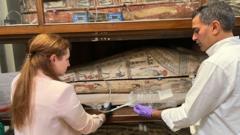Researchers from UCL and the University of Ljubljana discovered that ancient Egyptian mummies emit woody, spicy, and sweet scents, shedding light on the mummification process and conservation methods. They aim to recreate this aroma for display in museums, enhancing public engagement with history.
Ancient Egyptian Mummies Emit Pleasant Scents, Study Reveals

Ancient Egyptian Mummies Emit Pleasant Scents, Study Reveals
A groundbreaking study finds that 5,000-year-old mummies from ancient Egypt still carry delightful fragrances, offering new insights into their preservation and cultural practices.
The aroma of ancient Egyptian mummies has intrigued scientists, revealing a surprisingly pleasant olfactory profile even after thousands of years in sarcophagi. A recent study examined nine mummies, noting that while the intensity of their scents varied, all were characterized by woody, spicy, and sweet notes. The research team aims to synthesize these scents for display at the Egyptian Museum in Cairo, allowing visitors to immerse themselves in the ancient practices surrounding mummification.
Cecilia Bembibre, a key researcher, shared on BBC Radio 4's Today programme that the ancient Egyptians attached great importance to pleasant fragrances during the mummification process, believing it vital for the deceased's journey to the afterlife. Oils, waxes, and balms were commonly used to prepare pharaohs and the elite for this transition, emphasizing that the experience of encountering these scents contradicts popular portrayals of mummies in media.
The study published in the Journal of the American Chemical Society utilized a non-invasive method, inserting a thin tube into the sarcophagus to measure the scents without compromising the mummies inside. Bembibre remarked that this innovative approach enables heritage scientists to uncover information while preserving artifacts.
Cambridge University literature supervisor Ally Louks praised the project's potential to connect audiences with history in a novel way. "Engaging the sense of smell evokes a strong emotional and physical response," she explained, highlighting the pivotal role of scents in ancient Egyptian rituals and social practices.
Moreover, the research revealed that the identified scents could indicate the social class of the mummies. Matija Strlič, another researcher on the team, noted that this methodology could be invaluable across various museum collections.
The study also holds implications for mummy conservationists. By employing gas chromatography, scientists were able to analyze the breakdown of fats used in the embalming process, providing indicators for potential decomposition. This knowledge will aid conservators in developing best practices for storage and preservation, ensuring that these ancient relics can be maintained for future generations to experience.
As public interest in historical conservation grows, the sensory insights from ancient Egyptian mummies promise to transform the way we engage with the past.
Cecilia Bembibre, a key researcher, shared on BBC Radio 4's Today programme that the ancient Egyptians attached great importance to pleasant fragrances during the mummification process, believing it vital for the deceased's journey to the afterlife. Oils, waxes, and balms were commonly used to prepare pharaohs and the elite for this transition, emphasizing that the experience of encountering these scents contradicts popular portrayals of mummies in media.
The study published in the Journal of the American Chemical Society utilized a non-invasive method, inserting a thin tube into the sarcophagus to measure the scents without compromising the mummies inside. Bembibre remarked that this innovative approach enables heritage scientists to uncover information while preserving artifacts.
Cambridge University literature supervisor Ally Louks praised the project's potential to connect audiences with history in a novel way. "Engaging the sense of smell evokes a strong emotional and physical response," she explained, highlighting the pivotal role of scents in ancient Egyptian rituals and social practices.
Moreover, the research revealed that the identified scents could indicate the social class of the mummies. Matija Strlič, another researcher on the team, noted that this methodology could be invaluable across various museum collections.
The study also holds implications for mummy conservationists. By employing gas chromatography, scientists were able to analyze the breakdown of fats used in the embalming process, providing indicators for potential decomposition. This knowledge will aid conservators in developing best practices for storage and preservation, ensuring that these ancient relics can be maintained for future generations to experience.
As public interest in historical conservation grows, the sensory insights from ancient Egyptian mummies promise to transform the way we engage with the past.






















